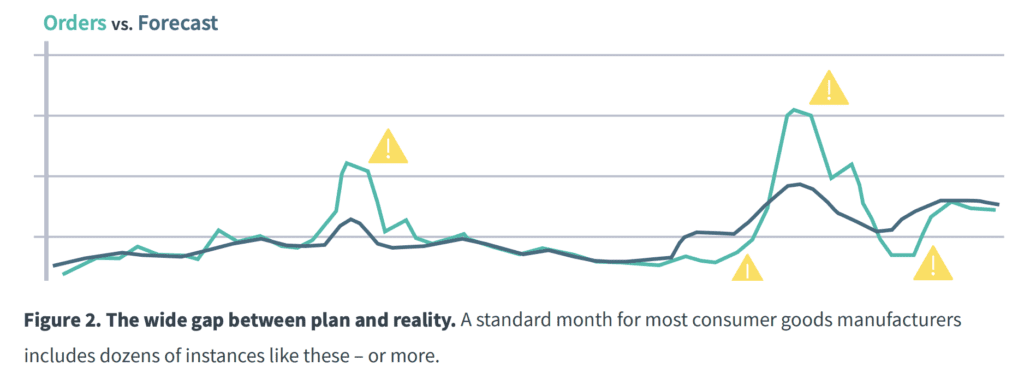Talking better product launch and allocation decisions with Ferrero USA
The global confectioner mitigates waste, improves service levels and controls costs by connecting digital supply chain visibility with POS analytics.
Keep readingAre your supply chain teams constantly firefighting, scrambling from one emergency to the next? COVID-19 is the most-recent dramatic example, but you’ve probably been fighting fires for decades.
It feels like you’re stuck racing from one crisis to crisis, spending countless hours on the phone and email conducting ad hoc analysis to cobble together solutions. Can you avoid out-of-stock events, OTIF fines and upset retailers? Can you prevent overstocks, markdowns…and (again!) upset retailers?
Wash, rinse, repeat.
The state of affairs takes its toll – wasted time, frayed nerves and low morale. It’s natural to want to pin the blame on someone. Forecasting and planning play important roles; maybe they’re guilty. Or perhaps the responsibility rests on manufacturing, deployment or customer supply chain.
The answer: reality is to blame. It never matches up with plan. And because of the gap between planning and execution, issues go undetected until fires erupt and supply chains again scramble to react.
If you’re caught in endless firefighting, take a deeper look at the causes (and solutions) that are lurking within your supply chain. Download our newest white paper: Why the chaos? Exposing the gap between planning and execution.
Demand and supply regularly deviate from plan. Week in, week out, changes come from business disruptions like natural disasters, accidents, policy changes and criminal activity, not to mention new social trends and unexpected consumer and customer behavior. Every once in a while, you’ll also suffer from Black Swan events like the Coronavirus pandemic, which are occurring with increasing frequency.

These disruptions are why forecast accuracy, which has long been the holy grail of supply chain management, remains lackluster. “If only we can accurately predict the future, firefighting won’t be necessary,” so the thought goes. But even after years of improvements involving increasingly advanced statistical modeling and technologies like AI, forecasts still average a 30% error rate.
In the three decades since the arrival of S&OP, it has failed to make a marked improvement on key metrics like days of inventory or lost sales due to stock-outs. In fact, only 65% of companies rate their process as effective compared to three years ago. That translates to over one-third of companies who think their S&OP is less effective today! Instead of improving, supply chain problems are getting worse. Execution wears itself out trying to prevent a different catastrophe every day.
Is it time to scrap the entire thing and start over from scratch?
No. S&OP serves an important purpose by helping align plans. But it can’t put an end to the firefighting, since you’ll never achieve forecast perfection. You can never prevent the unpredictable – but inevitable – ups and downs in consumer demand, customer orders and supply availability.
If supply chains are always firefighting, trying to extinguish one blaze before the next pops up, an obvious question forms: Is there a way to use “smoke detectors” and “building inspections” to find issues before they become disasters?
And who in the supply chain organization is responsible for that? After all, planners are focused on the future and demand forecasting. Execution is busy managing current operations, balancing costs and service levels. No one’s paying attention to the near-term issues that arise when reality deviates from plan – until it’s already out of control.
Even when a potential issue gets noticed, siloed data and organizational misalignments hamper supply chain visibility and collaborative decision making. Disconnects across people, processes and systems make it nearly impossible to craft timely solutions. By the time you notice a problem, then understand it and decide what to do… it’s often hard and costly to fix.
Bridging the gap between planning and execution will transform your digital supply chain. You’ll be able to catch and fix problems earlier, when they’re less costly and more within your control, and improve your supply chain resilience.
To do so, technology is mandatory. The scale and complexity of today’s supply chains simply generates too many data points for any analyst (or team of analysts) to realistically manage.
However, technology is not sufficient. Planners and execution teams are still critical to quickly make decisions and respond to changes, once they have the information they need. So empower them with real-time supply chain visibility across planning and execution systems, internal and external. Enable them to manage by exception with an alerting system that continuously looks for issues when reality deviates from plan and brings them to the surface.
Your supply chain can finally move from reactive to proactive – and begin to address issues before they become infernos.
To learn more about your organization’s gaps between processes, teams and systems and how they’re slowing you down, download Why the chaos? Exposing the gap between planning and execution.
The global confectioner mitigates waste, improves service levels and controls costs by connecting digital supply chain visibility with POS analytics.
Keep readingHow to take an iterative approach to digital supply chain transformation with real-time alerts that motivate teams to collaborate on issue resolution
Keep readingInventory Intelligence completes your digital supply chain transformation with a real-time control tower to bridge the gap between planning and execution.
Keep reading